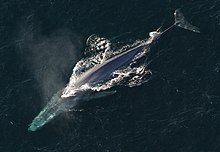Blue whale
The blue whale (Balaenoptera musculus) is a marine mammal of the suborder of baleen whales (called Mysticeti). They grow to be about 30 m (98 ft) long. The biggest blue whale found was 190 t (210 tons) and measured 98 ft (30 m) long.[3][4] Larger specimens have been measured at 110 ft (34 m), but never been weighed. This makes blue whales the largest animals to ever live on Earth, even bigger than the largest dinosaurs.
| Blue whale | |
|---|---|
 | |
Adult blue whale (Balaenoptera musculus) | |
Size compared to an average human | |
| Scientific classification | |
| Domain: | Eukaryota |
| Kingdom: | Animalia |
| Phylum: | Chordata |
| Class: | Mammalia |
| Order: | Artiodactyla |
| Infraorder: | Cetacea |
| Family: | Balaenopteridae |
| Genus: | Balaenoptera |
| Species: | B. musculus |
| Binomial name | |
| Balaenoptera musculus | |
| Subspecies | |
| |
 | |
| Blue whale range (in blue) | |
| Synonyms | |
The blue whale eats mostly very tiny creatures, like krill. These inch-long, shrimp-like crustacean swim in large swarms. In the Antarctic summer, there are so many of these krill that they turn the waters orange. A blue whale can eat 8 to 10 t (7.9 to 9.8 long tons; 8.8 to 11.0 short tons) of krill every day.[5]
The blue whale's body is long and slender. It can be various shades of bluish-grey above and somewhat lighter underneath.[6] There are at least three different subspecies: B. m. musculus of the North Atlantic and North Pacific, B. m. intermedia of the Southern Ocean and B. m. brevicauda (also known as the pygmy blue whale) found in the Indian Ocean and South Pacific Ocean. B. m. indica, found in the Indian Ocean, may be another subspecies. As with other baleen whales, its diet consists almost exclusively of small krill.[7]
Blue whales were once numerous around the world. In the nineteenth century, they were hunted almost to extinction by whalers. They were finally protected by the International Community in 1966. A 2002 report estimated there were 5,000 to 12,000 blue whales worldwide,[8] located in at least five groups. More recent research into the Pygmy subspecies suggests this may be an underestimate.[9] Before whaling, the largest population was in the Antarctic, numbering approximately 239,000 (range 202,000 to 311,000).[10] There remain only much smaller (around 2,000) concentrations in each of the eastern North Pacific, Antarctic, and Indian Ocean groups. There are two more groups in the North Atlantic, and at least two in the Southern Hemisphere. The North Atlantic group of Blue Whales can be seen in the Saguenay-St. Lawrence Marine Park near Tadoussac QC, Canada.[11]
References



